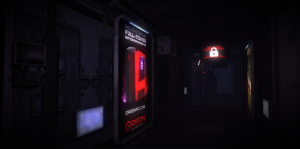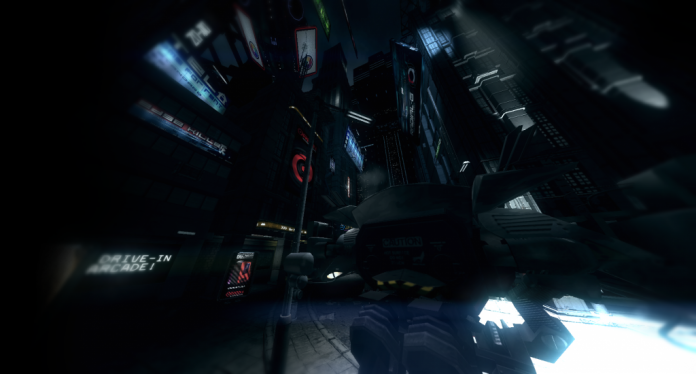Despite the label of IRIS VR as publisher, TECHNOLUST is essentially the brainchild of just one man: Blair Renaud. There are plenty of collaborators, actors, composers and more who have helped along the way, but it was one man’s mission that saw a hugely successful Kickstarter campaign build into a virtual reality (VR) launch title. TECHNOLUST is a bold take on creating a VR world, but the gameplay within is positioned as homage to years past.
The world of TECHNOLUST is a disease-ridden cyberpunk hole in which you make your way across a derelict city, progressing with the aid of a disembodied AI companion and some particularly rude interventions by distant ‘friends’. The world itself is traversable and full of intrigue, but ignoring the time spent marvelling at its creation this is only a minor part of the experience.
The core gameplay of TECHNOLUST acts on two front: puzzle solving and mini-games. The former often revolves around the latter. The player is given what on the surface appear to be relatively simple tasks – accessing documents, reaching destinations – but to do so requires more skill (or perseverance) than might be at first attributed. Blocked paths often require interaction with a videogame within the videogame, some of which an unofficial recreations of classic titles such as Space Invaders.
One of these retro-styled mini-games in particular is an inspired experience in VR. Labelled ‘Jack-in Jill’ in ‘Quinn’s Arcade’, the task set for the player is worked their way through an isometric labyrinth, killing enemies and finding keycards to progress. The entire of the level is viewable at any time however, simply by panning the players head. At the same time, the on-screen avatar’s aim is controlled by headlook, meaning that the player has to balance planning for progression whilst dealing with the immediate task at hand.
Despite the depths of fiction lovingly layered into each district of TECHNOLUST, from animated billboards to interactive objects and VR community in-jokes, there are some significant issues with the presentation. There are obviously areas and items which have received significantly more attention to detail than others, most noticeably in the quality of the lighting. Furthermore, there are a number of unfortunate bugs in the videogame, with falling through floors and occasional crashes having forced restart at an earlier save; somewhat annoying when saves are manual and not the first thing the player thinks of when immersed in a virtual world.

The sound quality of TECHNOLUST is astounding. The soundtrack is simply fantastic and contributes greatly to the feeling of being in a world very different to our own, while the voice-acting and effects are some of the best yet seen in VR videogames. Audio has been noted as often being a minor consideration for videogame development, yet is extremely important in VR to aid immersion. It appears that Renaud understands this all too well, delivering a soundscape exceeding the already commendable visual quality ten-fold.
TECHNOLUST is a more than respectable experience set in a captivating world. Though it has a number of flaws, it remains one of the most unique and interesting examples of indie development not just in VR, but in modern videogames as a whole. TECHNOLUST is a wonderful starting point for Renaud’s work in VR (his first release, Kerser, was in fact one of the mini-games taken from TECHNOLUST) and a fitting reward for those who have waited to jump into the cyberpunk future promised by the arrival of this new medium.















